Skullcandy Sesh Evo Fully Wireless Review
It’s no secret that for many users, a wireless headset is not only a way to listen to music and communicate, but also an element of style. And if we are already familiar with very good sounding solutions, then a truly original and catchy design is rare. The heroine of today’s test is Skullcandy Sesh Evo which can stand out quite strongly from the crowd, if only due to the bright color, not to mention the recognizable logo.
At the same time, Skullcandy Sesh Evo sounds acceptable, has good autonomy and a comfortable fit. It also have some drawbacks which we will definitely talk about them separately. Well, let’s start traditionally with the stated technical characteristics and design.
Skullcandy Sesh Evo Specifications
| Declared frequency range | 20 Hz – 20 kHz |
|---|---|
| Speaker size | ∅6 mm |
| CNI | <3% (1 kHz / 94 dB) |
| Connection | Bluetooth 5.0 |
| Codec support | SBC, AAC |
| Control | buttons |
| Autonomy | up to 5 hours |
| Autonomy taking into account charging from the case | up to 24 hours |
| Charging connector | USB Type C |
| Case dimensions | 78 x 38 x 34 mm |
| Case weight | 54 g |
| Weight of one earphone | 5 g |
Packaging and Equipment
The Skullcandy Sesh Evo comes in a black box with illustrations and brief specifications. The design seems to be pretty standard, but the skull on the logo immediately attracts attention.
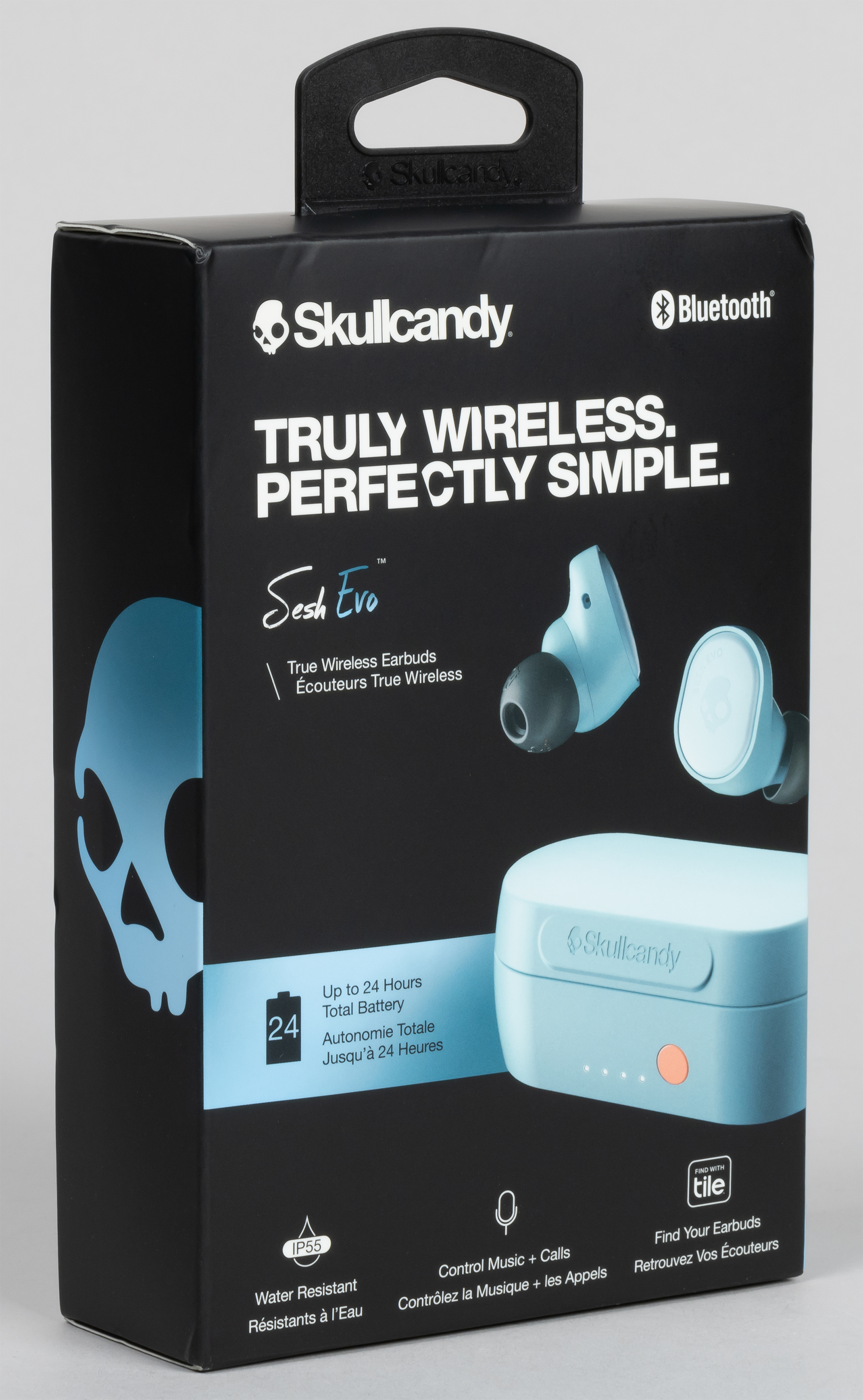
The Skullcandy Sesh Evo kit includes the headphones themselves, a charging case, instructions, a USB charging cable – USB Type C 25 cm long, documentation and a warranty card, as well as two pairs of replaceable silicone tips (one more is installed on the headphones initially).

The ear pads are quite low, the manufacturer’s logo is applied to the outside. The seam in the lower part is clearly visible in the photo, but in life it does not strike the eye. The mount is standard, it is quite possible to pick up a replacement in case of loss.
Design and Build Quality
The Skullcandy Sesh Evo is available in several colors. From bright and unusual blues, mint and dark red to classic gray and black. We had a blue version for testing.

The Skullcandy Sesh Evo case is far from the most compact of those that we have seen – 78 × 38 × 34 mm. You can’t put it in your pocket, but you can easily put it in a small handbag.
The manufacturer’s logo is applied to the front cover, below it there are four LED indicators of the battery charge and a button for their activation. The latter is colored orange and stands out noticeably against the general background, adding originality to the design.

There is nothing interesting on the top of the lid – just a painted matte surface. Which, by the way, is not at all prone to the appearance of touch marks.
At the bottom of Skullcandy Sesh Evo there are many icons of various certification systems, brief information about the manufacturer, and so on are found at once. At the same time, they are applied with a slightly darker paint of the same color, are not noticeable from afar and do not violate the integrity of the design.
At the bottom of the back surface of the case there is a USB Type C port for charging, above which you can see the lid fastening loop. The case is assembled well – there are no gaps or backlashes.
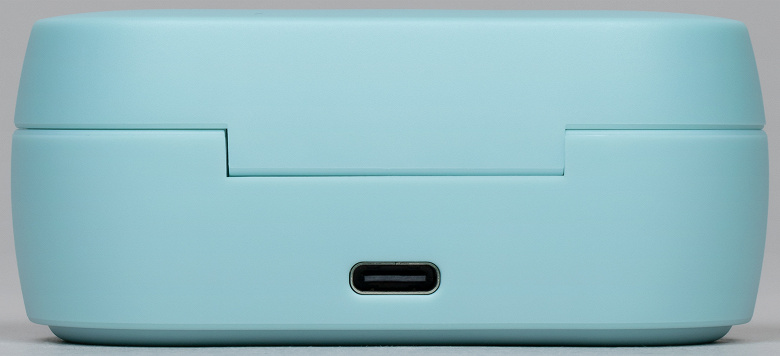
The lid opens without unnecessary effort and is fixed by a “closer” in extreme positions. The inner side bears the model name and number, as well as an indication that the device was manufactured in Vietnam.
The earbuds are held securely inside with a magnetic mount. It is not difficult to get them, you just need to pull a little on the rather strongly protruding part of the case towards you, as they “pop out” from their slots.

Spring-loaded charging contacts are visible inside the headphone slots. They are located in a kind of “wings” and not very deep – if necessary, they will be easy to clean. This, of course, can hardly be called a serious advantage of the headset in question, but the detail is pretty nice.
The Skullcandy Sesh Evo case is not very large, they look quite neat in the ears. The weight is also small – only 5 g.
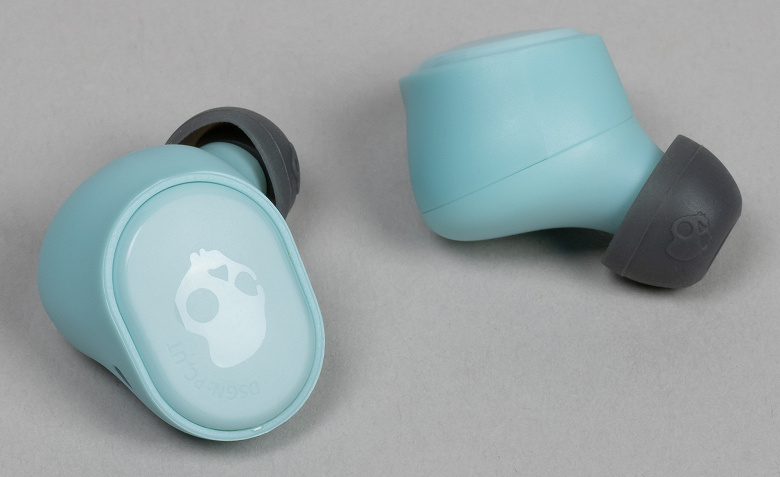
The ergonomic shape of the inner part of the Skullcandy Sesh Evo case provides high-quality support on the earcup, which makes the fit of the headphones comfortable and secure – we will return to this later.
The logo is applied to the outer side of the case, but this is done in the most restrained manner – if you wish, you can notice it, but it will not be striking.
The outer panels of the case are buttons that can be pressed easily and with a pleasant click, we will also return to them in the corresponding chapter.
On the protrusions of the inner part of the case, you can see the contacts for charging and the barely noticeable markings of the right and left earbuds – it will obviously be more convenient to navigate by the shape and position in the case.
The LED indicators of the operating modes are located on the side, which is very good: they are perfectly visible when the headphones are in the case, and are practically invisible while wearing.
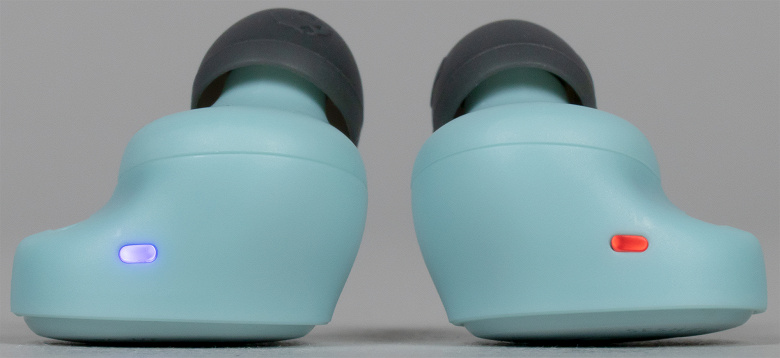
On the opposite edge of the case there are rather large microphone holes for voice communication.
When Skullcandy Sesh Evo is viewed from the side, it is clearly visible that the sound guide is not very long and comes out of the body at an angle. We have already talked about the logos on the silicone tips – the element seems to be simple and unobtrusive, but with it it is somehow more interesting.
The silicone tips can be easily removed and put in place, but at the same time they are held quite tightly due to the indentation on the sound guide nose.
The sound guide output is covered with a thin plastic mesh, which is almost level with its body – it will be more or less easy to clean it.
Connectivity
After removing Skullcandy Sesh Evo from the case, the headphones search for “familiar” sound sources for some time, if they do not find them, they activate pairing mode. Well, then everything is as simple as possible – we find them in the corresponding menu of the gadget and connect. The Skullcandy Sesh Evo notifies about the connection and other events with voice messages in English.
Skullcandy Sesh Evo multipoint does not support, which was checked by an attempt to connect it in parallel to a smartphone and a PC running Windows 10. At the same time, using the Bluetooth Tweaker utility, a list of supported codecs and their modes was obtained. The result is standard for a good budget headset: a basic SBC, plus a slightly more “advanced” AAC.

Each of the headphones can be used in mono mode by simply putting the other in the case. Switching occurs in a “seamless” mode – the music continues to play in the rest. The reverse transition to stereo mode also occurs quickly and without interruption of the track being played. When watching a video of the “desynchronous” picture and sound were not noticed, but in games it is quite noticeable. It should also be noted that Skullcandy has its own application for controlling headsets – Skullcandy App, but the budget Skullcandy Sesh Evo does not support it.
Controls
The Skullcandy Sesh Evo is controlled using buttons located on the outside of the case. They are pressed with a pleasant click and easy enough not to “press” the headphones into your ear until unpleasant sensations appear. It may not be the most “advanced” option today, but it’s definitely better than the poorly performing sensors in a lot of budget headsets we’ve come across.
Multiple taps are supported in Skullcandy Sesh Evo, with which you can not only control playback and flip through tracks, but also adjust the volume, activate voice assistants, and even switch between the three presets of the built-in equalizer. Presses are registered quite correctly, it only takes a little time to adapt to how quickly the button should be pressed.
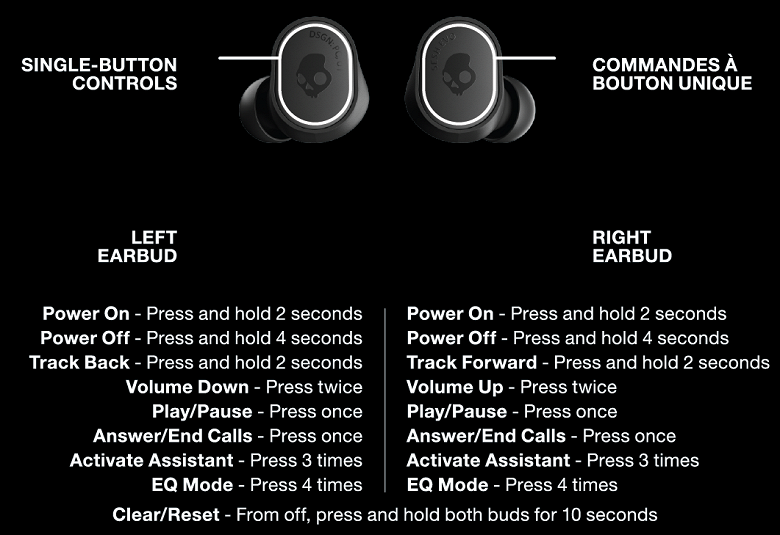
In mono mode, some of the control possibilities are lost. So, for example, if the user left the right earphone to work, he will only be able to increase the volume and scroll forward through the track. If left – respectively, zoom out and scroll back.
Skullcandy Sesh Evo Testing
The fit of the Skullcandy Sesh Evo is quite reliable and comfortable, but peculiar – they should be placed in the ear with a “twisting” movement, each time looking for the most comfortable position. Then it will be better with the transmission of the low frequency range, and the headphones will hold up well.
If done correctly, they will not fall out even with sudden movements during various activities, including jumping rope and twisting on an incline bench. Well, thanks to the protection against dust and water IP55, you can not be afraid not only of sweat drops, but also pouring rain while jogging – in general, headphones are great for sports.
As mentioned above, the Skullcandy Sesh Evo has three built-in equalizer presets, which can be switched between four times pressing the control keys: Music, Podcast and Movie. We will talk about the features of the sound of the headphones in each of them in the corresponding chapter. Also among the interesting features of the Skullcandy Sesh Evo, it should be noted compatibility with the Tile service, which helps to find a lost gadget.
It is enough to add the device to the service, and then click on the search button, as it will “respond” with a rather loud sound – it will become much easier to find it. For those who often rush around the house in search of a headset left unclear where, this can be a very popular opportunity.
The quality of the built-in microphones of Skullcandy Sesh Evo for voice communication is average. In a quiet environment, they can still cope with the task, but as soon as even a small background noise appears, the interlocutors begin to complain that it becomes much more difficult to make out speech. In general, everything is like with many headsets of the budget segment – you can exchange a few words, but for a longer communication it would be better to look at the solution more seriously.
In this testing, we tried a methodology for testing the autonomy of wireless headphones, which we will refine and develop in the future. Most often, manufacturers indicate a certain average operating time of headsets from one charge, without mentioning the conditions in which the measurements were carried out – in particular, the volume level, depending on which the result can change significantly. Fixing this parameter was the first priority.
A safe level of sound pressure when listening to music with headphones is 75 dB – it could be taken as a guideline. But in practice, most listeners prefer a level in the region of 90-100 dB. Let’s take the average value – 95 dB, and we will take measurements on it. We broadcast white noise to the headphones, fix the SPL level at a given value, immediately after the start, we start recording the signal from the measuring stand – by the length of the resulting track, it is easy to understand how long each of the headphones worked.
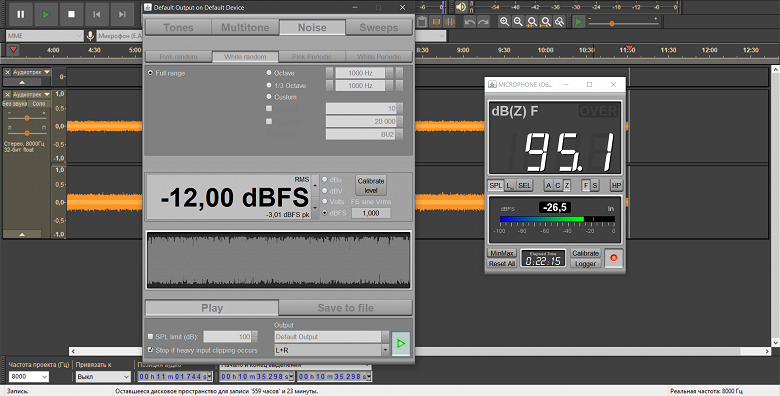
The stated working time is 5 hours. This is about how much the headphones worked in each of the three tests carried out.
| Right | Left | |
| Test 1 | 4:53 | 5:00 |
|---|---|---|
| Test 2 | 4:46 | 4:54 |
| Test 3 | 4:58 | 5:06 |
| Average value | 4:52 | 5:00 |
Fully charging the Skullcandy Sesh Evo headphones from the case takes about an hour, the case itself takes longer to charge – about 2 hours. The battery in the case is enough for 3 full charges of the earbuds, plus once again you manage to charge them by about 60 percent. The manufacturer claims 24 hours of total autonomy – this figure can be counted on. Fast charging is supported: 10 minutes in a case should give a little more than two hours of headset operation. Our result turned out to be more modest, but not much – 1 hour 43 minutes on average.
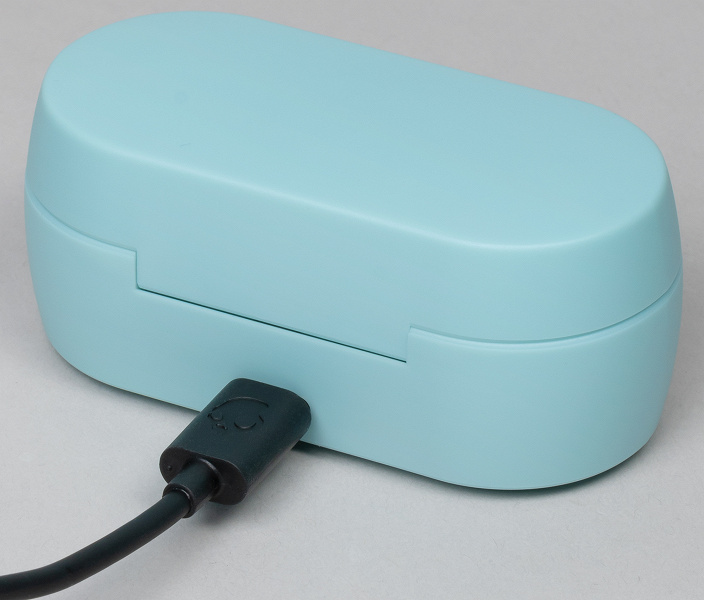
Sound and frequency response measurements
In marketing materials, the manufacturer promises “powerful sound with enhanced bass and crisp high frequencies.” In general, this is how it is, although not without reservations. The volume reserve of Skullcandy Sesh Evo is really quite impressive, but the low-frequency range, albeit forced, but slightly inclined to “hum” – in tracks with dense bass drums, this is especially noticeable. Correct selection of ear pads allows you to significantly reduce the severity of this effect, but not get rid of it completely. However, it is worth experimenting in any case at least in order to achieve more surround sound in the low frequency range.
The middle is worked out rather poorly, the accented bass periodically leads to a decrease in the detail of the vocals and parts of the solo instruments. The high-frequency range, although well developed, periodically reminds of itself with the so-called “sand” and problems with sibilants. In general, the sound is quite modest, a little brightness and volume would obviously not hurt it. But for its price range, the Skullcandy Sesh Evo sounds pretty good. On this, let’s leave our subjective impressions and move on to the frequency response graphs.
We draw the attention of our readers to the fact that the frequency response graphs are presented solely as an illustration to demonstrate the main features of the sound of the tested headphones. It is not necessary to draw conclusions from them about the quality of this or that model. The actual experience of each listener depends on many factors, from the structure of the hearing organs to the ear pads used.

The frequency response graph above is shown against the background of the IDF (IEM diffuse field compensation) curve provided by the manufacturer of the stand used. Its task is to help compensate for resonance phenomena in the simulated auditory canal and the characteristics of the equipment used, creating a “sound profile” that most correctly illustrates how the sound of the headphones is perceived by the listener. It can be seen as a device-specific analogue of the so-called “Harman curve” created by the Harman International team led by Dr. Sean Olive. Let’s compensate the resulting frequency response graph in accordance with the IDF curve.
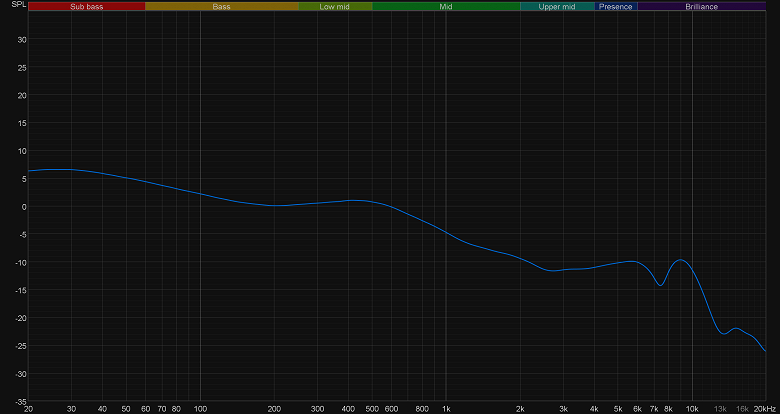
The peak at the top of the midrange in the target curve is intended to compensate for resonances in the simulated ear canal. In this case, they turned out to be not so pronounced, which gave us a visible dip on the compensated chart – we should not take it too seriously. As for the rest, the shape of the graph is consistent with the subjective impressions of listening to the headset. Finally, let’s look at the results obtained when all three equalizer modes are activated.
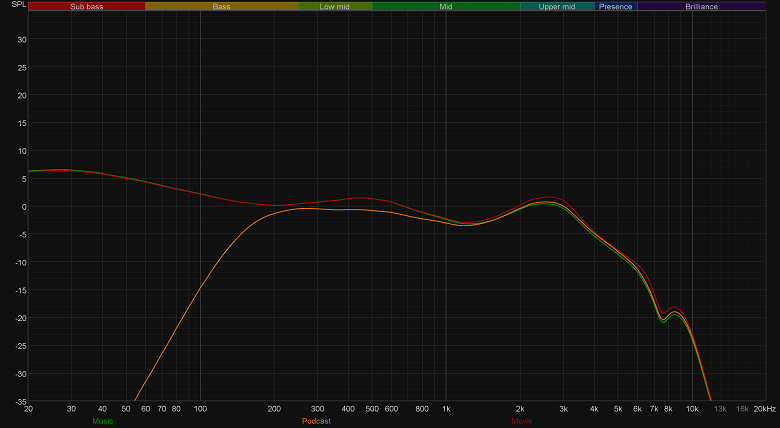
The main measurements, of course, were made with the activated Music profile. In Podcast mode, the emphasis is predictably placed on the midrange, with the bass almost completely relegated to the background. In Movie mode, the differences in sound are minimal – only the high-frequency range is emphasized slightly, and a little reverb is added.
Conclusion
Skullcandy Sesh Evo can be safely called a good budget headset. Yes, in terms of sound quality, it is inferior to many solutions, some of which even have a comparable price. And the quality of the microphones is far from ideal. But it is perfect for sports due to a comfortable fit and IP55 protection, has a rather interesting control system, can work with the Tile service … Again, the design is quite original, which is also an important factor for many users. In general, subtle connoisseurs of sound will hardly be interested in Skullcandy Sesh Evo, but as a headset for everyday needs and a fashionable accessory it can be quite interesting.
| Pros | Cons |
| Can be used either in solo or stereo mode | Can be used either in solo or stereo mode |
| Tile tracker built inside | Poor microphone noise handling capability |
| Dense plastic build | Mediocre microphone recording quality |
| EQ modes for film, music, and podcasts | |
| Affordable |
Also Check:







